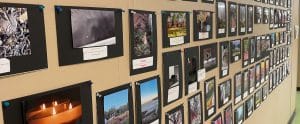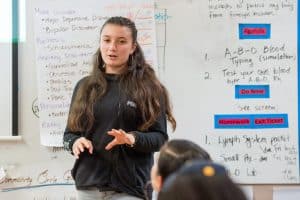Celebrating Readiness for the Next Challenge: Gateway at the Parker School
CompetencyWorks Blog
The energy and excitement of students literally fills the hallway as students loosely line up by the entrances of the room where they’ll soon watch a peer present their learning in a “gateway.” At the Francis W. Parker Charter Essential School, a gateway is a milestone marking when a learner has proven that they have demonstrated the learning expectations for one division and that they have the necessary Habits of Learning and skills to take on more challenging coursework in the next division, or for 12th graders, their post-secondary path.
 The Parker Charter Essential School in Devens, Massachusetts was founded on the 10 Common Principles of the Coalition of Essential Schools, which resonate with the Aurora Institute’s definition of competency-based education. Parker serves 400 students in grades 7-12 who are organized into three divisions, which typically, but not always, correspond to grades 7 and 8 (Division 1 or Div 1), grades 9 and 10 (Div 2), and grades 11 and 12 (Div 3).
The Parker Charter Essential School in Devens, Massachusetts was founded on the 10 Common Principles of the Coalition of Essential Schools, which resonate with the Aurora Institute’s definition of competency-based education. Parker serves 400 students in grades 7-12 who are organized into three divisions, which typically, but not always, correspond to grades 7 and 8 (Division 1 or Div 1), grades 9 and 10 (Div 2), and grades 11 and 12 (Div 3).
Learning is designed around Parker’s Criteria for Excellence, organized into the domains of Arts and Humanities (AH); Math, Science, and Technology (MST); Language (Spanish); and Wellness. Students meet the Criteria for Excellence through their coursework and then move through their “gateways.”
Day One of Four Days of Division 1 and 2 Gateways
My first block is a Div 2 Arts and Humanities (AH) gateway: its subject is “How can documentary photography tell stories?” Over that last month, Gillian has conducted independent research driven by her essential question and related sub-questions and worked on a culminating product, in this case, a series of photographs of friends and family members, each with an interview synopsis. Her advisor shared that while he was there for support and light guidance, Gillian and other students really led the research process themselves. The Division 2 gateway is based upon the portfolio of work and the independent research project, which is a stepping stone to the yearlong Division 3 senior seminar and project.
When asked why she chose her topic, Gillian explains that she was inspired by an “AE unit”—AE is artistic expression, one of the six competencies in the Arts and Humanities domain—on photography and wanted to learn more. Another Div 2 student shared that she had an ongoing list of possible gateway topics in her notebook and then a conversation with a teacher led her to explore the Fibonacci sequence and its influence on visual art. For a Spanish Div 2 gateway, a student researched the life and career of David Ortiz using Spanish sources. Students truly have the autonomy to choose their own topic and design an essential question sparked by their own interests and passions.
After each student presents for 20-30 minutes, there is time for questions from the audience, followed by warm feedback. The atmosphere is celebratory—family members are often in attendance and many rooms have fruit trays and boxes of donuts. While some of the students mention that they are nervous, they have already built their portfolio of evidence with a reflective cover letter to demonstrate their readiness. Getting to today really is based on being ready.
The Decision to Gateway is Based on Readiness
I get a chance to chat with Gillian as everyone mingles in the remaining time in our block. I ask her how she’s feeling after her gateway. She says, “I’m so happy, honestly. I’ve spent a long time—it’s been three years in Div 2 [for me], which is not always the norm. A lot of people spend two years, but at Parker we spend the time we need and move on when ready.” Gillian further reflects on her learning journey, explaining, “At the end of last year, I knew I wasn’t ready to gateway because I hadn’t proved I was ready. I came back this year and I put a lot of work in. I worked really hard to get all of the pieces I needed to be here. Pretty much taking the extra year allowed me to get the work done.”
Colleen L. Meaney, the Director at the Theodore R. Sizer Teachers’ Center echos that the culture and systems support students when they need more time, much like adults might need more time on a project in their professional lives. A student “might need more time to get more ‘Meets’ on their assessments. And that’s something that is communicated in a student’s lived experience here. They know that standard, so it’s extremely rare that it would actually feel like a surprise. It’s more that a student can see that they’re not quite there yet, and they might need another semester. And there’s probably somebody else in their classes who is there for an extra semester as well, so they see it in the community.”
Learning to Think (not just getting a correct answer)
Next, I head to 8th-grader Jacob’s Division 1 gateway. The Div 1 gateway for MST and AH is based on sharing two pieces of portfolio work for each domain. Students frame their AH presentation with a metaphor for their Div 1 experience. Jacob’s metaphor is that “Div 1 has been like learning to skate. At first you don’t know anything, then you work up to let go of the boards. As you get more comfortable, you start to skate faster.”
In his presentation, Jacob shares the trend data of his performance over his first two years at Parker, which shows growth in his Habits of Learning as well as how he’s earned more “meets” over time on his assessments. He reflects on the challenges in his transition to Parker. He describes how, at first, he didn’t feel comfortable with revision and didn’t revise his first five assessments. With encouragement—especially from his mother—and as he developed relationships with his teachers, he began to revise and started to get “Meets” on his assessments. Afterwards, his mother also reflects on the transition, sharing that, “Jacob talked about it well. He came from a place where it was just tests, homework, and [at Parker, you] have to unlearn what you are doing and learn how to do another process.”
Inquiry is a Habit of Learning that Jacob also identifies as an area of growth. He shares that he wasn’t curious at first, but then began to push himself to ask more questions. Jen, his MST teacher, describes that her goal for students is to teach them to think. She says, “Learning isn’t just the transactional thing that ‘I gave you information, now give it back to me.’ But ‘I gave you information, what can you do with it?’ And like I said in Jacob’s comments, in his two years with me, he’s done an exceptional job at learning how to read that feedback, think about it, and act on it.”
Jacob’s AH teacher explains that in Division 1 students learn how to reflect and be agents in their own learning. He offers a metaphor, saying, “They go from sitting in the school bus of their learning to driving the school bus of their learning.” And Jen chimes in with, “Or at least they have their learner’s permit.” Jacob’s dad elaborates on “the Parker way,” sharing, “We have kids at every single division level and we’ve seen the evolution. And by the end of their career, they really are driving the bus of their learning. They really do teach kids how to think and not just be rote learners who regurgitate the information, but to really think about it deeply. And the whole ‘less is more’ philosophy is really important for that.”

Creating a Culture of Learning
The processes of promotion by portfolio and gateway make the expectations for learning clear to everyone. Colleen describes the system as a “competency-forward model” because the Criteria for Excellence are visible and deeply known by everyone. Gillian explains, “Everyone has to go through the gateway process at Parker, so it’s less scary to present because everyone has to do it at some point. So we all come from the understanding that this is a big deal and there’s a lot of work that leads up to it. It’s a big accomplishment to prove to yourself and your peers that you’re ready to go on to harder challenges.”
The systems and structures at Parker support students in being ready to meet those expectations. As teachers guide students through academic content and the Criteria for Excellence, they also intentionally cultivate the skills of learning by encouraging reflection, revision, and independence. From clear, common expectations, to meaningful assessment and agency, the elements of Aurora’s competency-based education definition are visible throughout my time at Parker.
Laurie Gagnon is the Aurora Institute’s CompetencyWorks Program Director.
